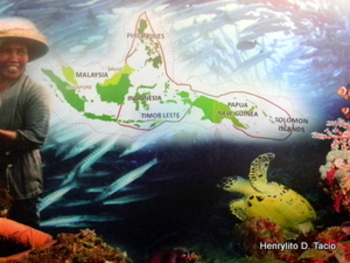Text and Photos by Henrylito D. Tacio
CAIRNS, Australia 16 July 2012. Unless the governments and the people of the Coral Triangle Region will work together, their ecologically-fragile coral reefs may vanish without a trace just like those what happened in the Bermuda Triangle.
The Bermuda Triangle is a region in the western part of the North Atlantic Ocean where a number of aircraft and surface vessels are said to have disappeared under mysterious circumstances.

Maurice Knight: Save corals from extinction in the Coral Triangle
“It is most likely that the corals will disappear completely from this part of the world,” warned Maurice Knight, the Chief of Party of the USAID (United States Agency for International Development) Coral Triangle Support Partnership.
The Washington-based World Resources Institute predicted by 2050, 90 percent of regional reefs would be threatened by 2050. “So scary I don’t want to believe it,” said leading Indonesian scientist Jamaluddin Jompa. “It will be the end of the Coral Triangle story if it ever comes true.”
The Coral Triangle (CT) – so named because of its distinct triangular shape, is a region in Asia that includes the Philippines, Malaysia, Indonesia, Timor-Leste, Papua New Guinea, and the Solomon Islands.
Spanning the marine waters of these countries is the global heart of coral reefs. It encompasses nearly 73,000 square kilometers of coral reefs which, as someone describes, an “Eden beneath the waves.”
“This magnificent area, often called the ‘Amazon of the Seas,’ contains nearly 30 percent of the world’s coral reefs and 75 percent of all known coral species,” said Suseno Sukoyono, executive chair of the Coral Triangle Initiative on Coral Reefs, Fisheries, and Food Security.
Not only that. The CT region is home to more than 3,000 species of fish – “twice the number found anywhere else in the world,” to quote the words of Sukoyono.

The Coral Triangle in the Far East is home to more than 3,000 marine animal species compared to elsewhere.
Unfortunately, like most coral reefs around the world, the CT is under increasing pressure from a range of serious threats: unsustainable fishing, surging population, and growing urban and rural development.
Compounding the problem is the effects of climate change brought about by global warming. Some studies have shown that 5 percent of CT reefs faced global climate change threats.
“Tropical coral reef waters are already significantly warmer than they were and the rate of warming is accelerating,” said Janice M. Lough, of the Australian Institute of Marine Science. “With or without drastic curtailment of greenhouse gas emissions we are facing, for the foreseeable future, changes in the physical environment of present-day coral reefs.”
Philip L. Munday, of Australia’s James Cook University, said changes to coral reef habitat caused by climate will potentially lead to changed fish populations. The direct impacts, which are already occurring, are reduced coral cover and less habitat structure for fish.
“That will mean fewer species and lower fish abundance,” Munday said. “Some species will fare better than others. For example, fish that eat coral will be more severely impacted, but overall we can expect a decline in fish numbers.”
This is bad news for those living in the CT region, where more than 130 million people depend on coral reefs for food and income.

Warming waters lead to coral bleaching, a major threat to the Coral Triangle. And that is just one threat among many.
“In both Indonesia and the Philippines, more than one million people are dependent on reef fisheries for their livelihood,” said the newly-released Reefs at Risk Revisited in the Coral Triangle. “In Solomon Islands, more than 80 percent of households engage in fishing.”
“Coral reef fish yields range from 20 to 25 metric tons per square kilometer per year from healthy reefs,” said Angel C. Alcala, who received a Ramon Magsaysay Award in 1992 for “his pioneering scientific leadership in rehabilitating the coral reefs of the Philippines.”
Coral reefs are found in warm tropical and subtropical regions. The reef is built primarily by coral polyps, which are cylindrical in shape with a pouch-like mouth surrounded by tentacles that capture prey and bring it into the mouth.
These organisms attach themselves to the floor of coastal waters. They secrete calcium, which acts like a substrate for other individuals. As these calcium deposits increase, coral reefs are formed. Only the surface of the reef contains living organisms. The rest is just the remaining calcium deposits.
Some corals have a symbiotic relationship with algae that lives within the coral’s cells. The coral captures its food at night, but during the day, they are nourished directly from the photosynthesizing algae living within their body.
Dr. Jane Lubchenco, undersecretary of Commerce for Oceans and Atmosphere, said: “It is difficult to put a precise dollar value on the many benefits provided by coral reef ecosystems.”
Photos by Henrylito D. Tacio and Paul F. Llanos.